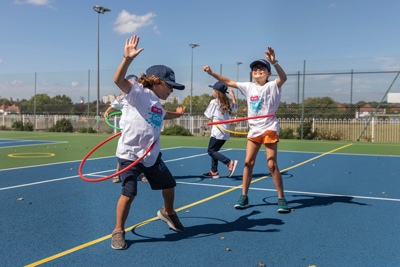
by Mrs Sarah Bakhtiari
Principal of Shoreham College
I have been a head teacher for six years, in two schools. A mother for 24 years, married for 30 and an educator for 29. When I was pregnant with my eldest daughter, I decided to do a Masters because I thought I would be bored with a newborn. The reason I reel off this list is that I couldn’t do these things without resilience (and optimism and foolishness – but they are different articles, and so I shall stick to resilience today!).
There is a buzz around resilience. I’ve been on training courses for it; read books and articles about it; been told I need more of it. The trouble is, I’m quite suspicious of the idea of resilience. The more I think about it, the more I’m reminded of a game I used to play on rainy days as a small child.
On said rainy day we would get the board games out of the cupboard and my family would all play. While it’s hard to choose a favourite, if I had to, it would be Buckaroo. The plastic donkey pressed into position before my brother and I took turns to pile all the random miscellany on its back, seeing how much the donkey could take before everything got bucked off. The moment it sprang and threw the plastic novelties all over the floor always made us jump and giggle, before we started the whole process all over again. That poor donkey never seemed to get much peace, being tested to its limit over and over. But that’s how I feel when people talk about how we should all be more resilient, as if we’re all plastic donkeys being piled upon until we snap.
Our children will encounter a myriad of challenges in their lives – everyone I’ve encountered has faced difficult times at some point. While some may have to overcome larger obstacles than others, every single person experiences struggles. Life is undeniably beautiful, yet equally tough.
How do we prepare our children to face the complexities and thrive?
When we talk about resilience, I think that what we mean is being able to face the complexities, the curved balls and the challenges of life and emerge on the other side, and I understand that, but I also think there’s more to it.
Let me illustrate. I love to swim. I’ve got into the super-trendy pastime of outdoor swimming, mostly in the sea. However, earlier this year, I visited a friend who insisted I got into the choppy North Sea. The waves didn’t look that big and I’m used to the cold, so I waded in. The first and second waves were fine and I began to relax – perhaps too much – and only when the third wave was a foot away from my face did I realise I’d misjudged it. I hadn’t widened my stance or braced myself for impact and over I went, and got a mouthful of the North Sea and a face full of shingle. I learned in that moment that resilience is also about bracing for the wave. Realising the thing that’s approaching is going to leave you a little battered, doing all you can to get ready for it and, when it’s over, all you can to recover. Life will break you at points, you can’t help that, but what you can do is be as ready as you can be for its knocks and bruises and work on healing them as quickly as possible. That’s what I hope we mean by resilience, but the trouble is, resilience seems to have become a code word for something else.
We’ve all felt it – that moment when the list starts to mount. We all like to please people, all like to help where we can. Perhaps you’ve agreed to bake for the winter fair and that on its own is fine, but then you also have to finish the last bit of work, remember to pay a bill and call your friend to wish them a happy birthday. You get jostled in the supermarket and suddenly it all becomes too much. The Buckaroo donkey can’t hold it any more and bucks. Perhaps you need to be more resilient, or perhaps it might be time to acknowledge your limits.
Resilience has transformed into a notion that implies we must endure hardships silently and soldier on. The truth is, I am vulnerable. But my vulnerability does not make me weaker (or stronger) than anyone else. True strength isn’t about bravely facing life’s pressures and forcefully overcoming obstacles as if they don’t exist. It’s about acknowledging our weaknesses and vulnerabilities. Strength is honed through moments of vulnerability. While resilience portrays a triumphant figure plowing through obstacles, strength often manifests as a tearful heap – overwhelmed, exposed, yet unapologetically authentic. Resilience appears to be an individual pursuit, while strength thrives on collective support, where we can lean on one another and draw strength from those around us.
Allow me to share an analogy. My dog died last year. A much-loved family pet suddenly wasn’t there any more, and I was devastated. A time for resilience, perhaps? But I did something else. I cried and cried and cried. I cried in the departure lounge at the airport, I cried arriving at the hotel, I cried over breakfast in the morning, and at night-time. The other holiday makers were really confused. My husband and daughters didn’t try and stop me, they just acknowledged I was hurting.
I didn’t need to be more resilient; I needed to stay broken for a bit and lean on the strength of others. I found a strength that didn’t come from brushing myself off and getting on with it, but rather from feeling the pain and sitting with it for a while. And I still miss my dog, but now it’s peaceful instead of raw.
Resilience sometimes feels like we are supposed to cover up the scars, but strength allows them to be seen as if they are badges of honour, scars that made us who we are.
So, when I’m in resilience training and people are talking about how to cope with what’s going on, I can’t help but picture that Buckaroo donkey and, well, I’m not having that. Life is tough, but the stuff you do have to carry is less of a burden if you let people who care about you hold it for you, even just for a little while.
If life is the mountain, resilience is about powering up it without taking a break and pretending you aren’t out of breath and you don’t have blisters. Whereas true strength is about acknowledging you can’t take another step and asking if anyone fancies a sit down. The beauty is that when you take that precious moment to pause, you can also take a look at the path you’ve just walked up and who you’ve walked it with and be surprised by the ground you’ve covered. By admitting small defeats and looking down the mountain, you are less likely to lose sight of the bigger picture and what it took to get you there, feeling your feet on the ground and anchoring yourself.
You don’t have to be anyone’s Buckaroo donkey: you’ll only get overloaded, flip and make a mess. There’s nothing wrong in saying it’s all a bit too much.
So, what does this mean for our children and schools? Research tells us that the children who perform the best are those who can ask for help, act on it and have the strength to persevere – and not in buckaroo style, but in a collective endeavour with you, with their school and with their peers. Our children learn from us – let’s show them strength in all its forms. When your children need support, let their school know and let them work with you to put that supportive net around them and when you need support, I hope you have the people around you who will work through it with you, in whatever form you need.
Please call 01273 592681 to find out more about what Shoreham College can offer you, or to arrange a personal visit at any time of the school year. www.shorehamcollege.co.uk



 ave time to figure it out together!
ave time to figure it out together!






 The ability to write is an essential skill to learn and a tool for life. It is interesting to understand that developing children’s upper body strength is essential to help them control their hands and fingers. This is because there is a strength domino effect which starts at the top: once children can control the large muscle groups of the shoulder, upper back and core, they are able to exert more control on their upper and lower arm, which in turn enables them to control their hand well, before finally achieving fine motor control in the fingers. By climbing, pulling themselves up and hanging down, the muscles in the shoulder are well exercised and this has huge benefits for handwriting and, as they grow older, handwriting at speed.
The ability to write is an essential skill to learn and a tool for life. It is interesting to understand that developing children’s upper body strength is essential to help them control their hands and fingers. This is because there is a strength domino effect which starts at the top: once children can control the large muscle groups of the shoulder, upper back and core, they are able to exert more control on their upper and lower arm, which in turn enables them to control their hand well, before finally achieving fine motor control in the fingers. By climbing, pulling themselves up and hanging down, the muscles in the shoulder are well exercised and this has huge benefits for handwriting and, as they grow older, handwriting at speed.










